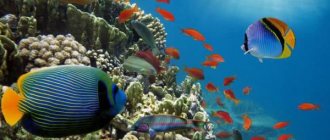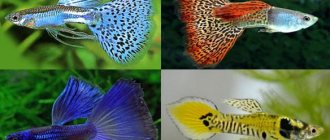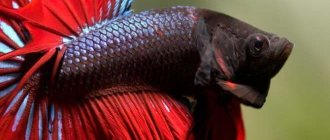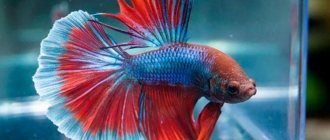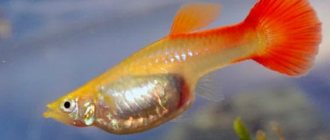02/12/2019Pisces0
The varieties of guppies are many and varied. These bright fish, swimming on the surface of the water in colorful schools with developing tails, are a decoration for any aquarium.
- 1 Description and habitat
- 2 Main types 2.1 Tail shape
- 2.2 Color
Description and habitat
In the wild, guppies live in fresh water bodies from the south of North America and throughout South America. The natural coloring is not as bright as that of the selected species - gray with a greenish tint with transparent rounded fins. Guppies live on average 3 years, but with good care their lifespan can reach 5 years.
Thanks to many years of work by breeders, there are many species of guppies, which are replenished every year. Fish are classified according to body color and fin shape.
| Type name | Description |
| Albinos | Absolutely white body and bright red eyes. |
| Moscow guppies | Green, purple, blue, white fish with a metallic sheen. |
| Panda | The front abdomen is painted white, and the upper part of the head, the back of the body and the tail are black. |
| Neon | Painted in pearlescent shades - white, yellow, blue, green, purple. |
| Spaniards | The main body color is black or dark blue. The tail is yellow with a red border and a black pattern. |
| Leopard | Their color resembles leopard skin. |
| Tuxedo | The fish seems to be “dressed” in a tuxedo. The back of the body is much darker than the front. |
| Carpet | A distinctive feature is the tail. The pattern on it resembles a mosaic. There are yellow, red, blue and green. |
| Japanese | Semi-black body color with bright spots and stripes of yellow, green, blue, red and their shades. |
| Berlin | The color of the fish’s body varies from light in the head area to dark. The fins are red. |
| Red Dragon | Bright red color throughout the body and fins; some have red eyes. |
| Snake color | They have a body color with a metallic sheen, with stripes and spots reminiscent of a snake print. There are blue, green, yellow, red shades. |
| Blond | They are distinguished by a white front part of the body, with a smooth transition to a different color to the tail and fins. There are blue, red, yellow blondes. |
| Sunset | Silvery body with a reddish-orange tint on the fins. |
There are 13 varieties of guppies based on the shape of their fins, the most common are presented in the table.
| Veiled-tailed | Sharp-tailed fantail |
| fantail | Speartail |
| Double sword | Flagtail |
|
|
| Round-tailed |
Other types
- Sunset. The color is dominated by the colors characteristic of the evening sky: yellow and red.
- Galaxy is a fish with a scattering of black dots on a multi-colored background.
- Martin. The guppy's tail has elongated rays, which makes it look “ragged.”
- Red multicolor carnation. Variegated plumage of a brick shade with a black pattern.
- Berlin. The guppy's fins are scarlet, and the body has orange, silver and gray tones.
Maintenance and care
Guppies are undemanding in care, but are very sensitive to water quality and sudden changes in parameters. Moreover, the easiest to keep guppies are gray in color, followed by light and dark subspecies, and albinos and neon fish are considered the most whimsical.
Also keep in mind that guppies are schooling fish, and you need to introduce them into the aquarium at least in a group, 1 male and 2 females. For larger numbers, count 2-3 females per male.
Aquarium
In terms of aquarium volume, guppies are unpretentious and can live in even a three-liter jar. But for comfort and for the fish to reach their maximum size, one male requires 1 liter of water, and a female requires 2. Also equip the aquarium with a lid, guppies are very active fish and can jump out.
Water requirements
The life expectancy of a guppy, its size and color characteristics depend on water indicators. Guppies are most sensitive to the acidity of water. The optimal indicator is 7-8.5 pH. They are less sensitive to water temperature - 20-26 °C, and hardness - 10-25 dH.
Every week you need to do a water change, but no more than 20% of the volume. To update, use only settled water.
Equipment and lighting
Guppies pollute the aquarium quite heavily, so a filter is needed. The internal one will be enough, but the external one is still better. You will also need an aerator.
Fish need lighting at least 12 hours a day. Place the aquarium in a bright place, without direct sunlight, or equip it with a lamp with a moderate warm spectrum of light.
Soil and plants
One of the best plants for a guppy aquarium is the Indian fern. It acts as an indicator of well-being - if it grows near the bottom, then everything is fine. If the roots of a plant begin to rot and it dies, then the microclimate in the aquarium has worsened and urgent measures must be taken (replace some of the water, increase filtration). If you want to add more greens, here's what you can do:
- brazilian periofolia;
- riccia;
- Elodea canadensis.
Use purchased or river sand as soil. The main thing is that there are no salt impurities in it (this can increase water hardness).
Launch into a community aquarium
When can you safely add fry to adult fish? The answer is simple: as soon as they grow enough to avoid being eaten. Age doesn't really matter. Some individuals can be quite large after two weeks, while others remain tiny at this time. A general rule for all fish, not just guppies: when the fry have grown to 1.5 cm, they are ready for transplanting.
Before global relocation, you need to make sure that the raised babies will survive in a common aquarium. To do this, the tank must have a lot of shelters: plants among which the guips can hide. From among the inhabitants of the aquarium, it is necessary to exclude aggressive and predatory fish, for which small guppies will become tasty prey.
On a note! The fry should be prepared for transplantation gradually: lower the water temperature, bringing the parameters of the fish tank closer to those of the general tank.
Guppy breeding
Guppies are viviparous fish and reproduce quite easily without special conditions. After courtship, the male fertilizes the eggs directly in the female’s body using a tube-shaped anal fin.
Female guppies have a unique feature: after one fertilization, they can produce 6-7 litters of fry.
The gestation period depends on the conditions of detention and varies from 3 to 7 weeks. When the female’s abdomen becomes noticeably rounded, swells and turns red, and a dark spot appears on the anus, it’s time to place the expectant mother in a separate container. Create the following conditions for the female:
- temperature - 26-27 °C;
- It is better to take water from a common aquarium when replacing;
- Before giving birth, feed the expectant mother bloodworms, this will give her strength.
Guppies give birth to viable, fully formed fry. The number of children depends on how pregnant the female is. So, the first time she is able to bring 10-30 fry, the second - up to 60, and the third - up to 100.
Immediately after birth, remove the mother from the fry, she may simply eat them. For full growth and health, the fry require clean water, and if there is no aeration and filtration in the tank with the babies, then it is better to equip them with a shelter in a common aquarium.
Feed your babies small portions at least 3 times a day with live dust. As they grow, reduce the number of feedings to 2 times a day, and add brine shrimp and chopped tubifex to the diet. You can also use dry food, just grind it into dust.
After 2 months, the fry will reach the size of their parents, and they can be released into the general aquarium.
Guppies are ideal if your child asks for an aquarium. Guppy - red flamingo
0
The small size of the fish will allow you to keep 5 - 7 pieces in a 15 - 30 liter aquarium installed on a desk. If there is a low density of fish and the presence of undemanding living plants, you can refuse to filter and aerate the water. The main thing is not to forget, in this case, to change the water more often and clean the soil.
Of course, additional lighting is needed, but a table lamp is quite suitable as it in the evening. You can feed dry or industrial food from a jar. The fish can easily endure a week-long hunger strike in your absence, and there is no need to ask their neighbors to feed them; accidental overfeeding, with the best intentions, can lead to water damage and death of the fish. As you can see, the costs of time and finances in this case are not great. Currently, guppy fish are distributed in nature in most warm-water fresh water bodies. They spread artificially in order to fight the malaria mosquito, as they happily eat their larvae. Initially they existed in Brazil, Venezuela and Guiana. There are local populations even in Russia, in places where warm runoff is discharged. They were apparently started by aquarists who released fish there.
Compatibility with other fish
Peace-loving and non-conflict guppies get along best with close relatives from the poeciliaceae family. Guppies are defenseless against other fish, and no matter who you place them with, arrange shelters - dense bushes of plants.
The table shows the compatibility of guppies with other fish.
| Compatible |
|
| Limited compatibility |
|
| Not compatible |
|
When choosing neighbors, also take into account the similarity of living conditions, feeding and dimensions of the aquarium. Introduce the fish at the same time, this will reduce the risk of conflicts over territory and food.
How to distinguish a male from a female
Guppies have pronounced sexual dimorphism, and already at two weeks of age it is possible to distinguish a female from a male.
| Male | Female |
| Grows up to 3 cm in length | Reach 6 cm |
| They have an elongated and long body | Have a more rounded body |
| Have a brighter color and pattern | Compared to males, noticeably paler |
| The dorsal fin is large and seems to flow while swimming. | The dorsal fin is smaller |
| Narrow and long anal fin with a pointed end | Short anal fin, triangular in shape |
Diseases
Guppy diseases can be caused by poor care and infection from contaminated food, plants or other fish. The most common ailments in guppies are problems with their fins:
- Fin compression. Appears due to monotonous and poor nutrition during growing up. Treat with salt baths (1 g of salt per 1 liter of water).
- Fin separation. Most often, the caudal fin splits into several parts. Occurs due to fighting or lack of vitamin D. To treat, add 0.1 ml of iodine to the aquarium for every liter of water.
- Fin rot. Appears due to improper maintenance and infection. Ulcers form on the edges of the fins, which quickly grow over the entire surface. During the process of rotting, the fins disintegrate. Treatment should be with 20-minute salt baths (3 teaspoons of salt per 5 liters of water) and streptocide solution (1.5 mg of medication per 10 liters of water). Also be sure to disinfect the aquarium and rinse the plants and soil. Treatment is continued until the disease subsides.
- Red scab. A scarlet coating appears on the edges of the fins. The disease is caused by the parasite Tetrahymena. Remove infected guppies from the general population. To cure the fish, use a blade to remove the affected areas of the fins and use a solution of chloramphenicol (1 tablet per 20 liters of water). Salt baths also help well. Continue treatment until the fish is completely cured.
Guppies are an excellent choice for beginner aquarists; they are unpretentious, easy to breed and delight with their activity and cheerfulness. Experienced lovers of aquarium inhabitants will enjoy representatives of rare selected species and colors of guppies. They are more demanding to care for, but also incomparably more beautiful.
Guppies!
0
×
0
For many amateur aquarists, this hobby began with her, and experienced aquarists sometimes do not forget about guppies. This is a favorite subject for the study of genetics. The discussion above was about males; they are distinguished by large tails and bright, varied colors. Their sizes are small: 1.5 -3 centimeters. Females are much larger, up to 6 centimeters, but inconspicuous. The color is grayish, there are no large tails. Although in aquariums there are partially colored females with enlarged caudal fins. Various color options and body shapes can be seen in the photo on the left.

